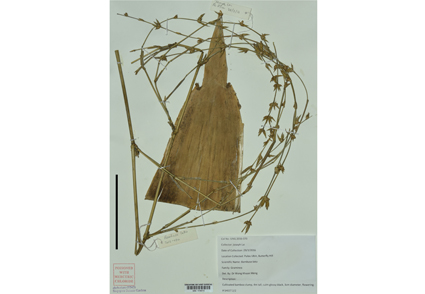Abstract
Bambusa lako, known in horticulture as Timor black bamboo, described without flowering material initially, is a common ornamental bamboo in Southeast Asia because of its moderate size and purplish-black culms when matured. During specimen examination at the Herbarium of the Singapore Botanic Gardens, a flowering collection of B. lako came to our attention. After careful dissection and comparison, we found that the reproductive characters resembled the genus Gigantochloa rather than Bambusa, such as short rachilla segments that do not disarticulate, terminal vestigial florets and filament tubes. Therefore, the floral features were supplemented and a new combination Gigantochloa lako was proposed.
References
- Goh, W.L., Chandran, S., Lin, R.S., Xia, N.H. & Wong, K.M. (2010) Phylogenetic relationships among Southeast Asian climbing bamboos (Poaceae: Bambusoideae) and the Bambusa complex. Biochemical Systematics and Ecology 38 (4): 764–773. https://doi.org/10.1016/j.bse.2010.07.006
- Goh, Y.X., Yap, S.P. & Tong, T.Y. (2020) Bamboo: the emerging renewable material for sustainable construction. In: Hashmi, S. & Choudhury, I.A. (Eds.) Encyclopedia of Renewable and Sustainable Materials. Elsevier, New York, pp. 365–376. https://doi.org/10.1016/B978-0-12-803581-8.10748-9
- Holttum, R.E. (1958) The bamboos of the Malay Peninsula. The Gardens' Bulletin Singapore 16: 1–135.
- Loh, J.P., Kiew, R., Set, O., Gan, L.H. & Gan, Y.Y. (2000) A study of genetic variation and relationships within the bamboo subtribe Bambusinae using amplified fragment length polymorphism. Annals of Botany 85: 607–612. https://doi.org/10.1006/anbo.2000.1109
- Munro, C.A. (1868) A monograph of the Bambusacea, including descriptions of all the species. The Transactions of the Linnean Society of London 26: 123−130. https://doi.org/10.5962/bhl.title.15634
- Nees von Esenbeck, C.G.D. (1835) Bambuseae Brasilienses. Linnaea 9 (4): 461–494.
- Roxas, C.A. (2012) Handbook on erect bamboo species found in the Philippines. Ecosystems Research and Development Bureau, Department of Environment and Natural Resources, College, Laguna, 19 pp.
- Schreber, J.C.D. (1789) Genera Plantarum Ed. 8 Vol. 1. Francofurti ad Moenum: Suntu Varrentrapii et Wenneri, Francofurtum ad Moenum, 236 pp.
- Teh, C. (2016) Landscaping with tropical bamboos. UTAR Agriculture Science Journal 2: 42–46.
- Widjaja, E.A. (1987) A revision of Malesian Gigantochloa (Poaceae—Bambusoideae). Reinwardtia 10: 291–380.
- Widjaja, E.A. (1997) New taxa in Indonesian bamboos. Reinwardtia 11: 57–152.
- Widjaja, E.A. (2019) The Spectacular Indonesian Bamboos. Polagrade, Jakarta, 188 pp.
- Wong, K.M. (1995) The Bamboos of Peninsular Malaysia. Forest Research Institute, Kuala lumpur, 200 pp.


